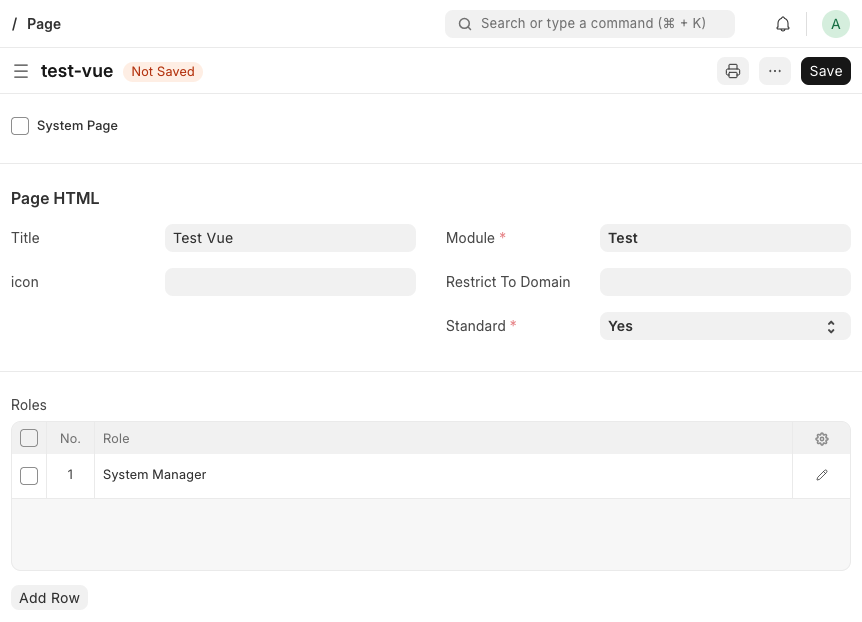Using Vue in a Desk Page
Using Vue to add pages to your Desk based app gives you a best-of-both-worlds type of convenience:
- You get to use Vue with its reactivity and composability
- You get to use Frappe JS APIs
This is possible without having to manually configure a Vue app. You can follow the steps below to set it up.
Create a Page
Navigate to the Page DocType (at /app/page) and create a new Page entry.
New files will be created for your page in the module you select.

Check created files
Under the module folder in your app's directory, you'll find a new folder with three files in it:
└── app
└── app
└── module
└── page
└── test_vue
├── __init__.py
├── test_vue.json
└── test_vue.js
Among these, in the newly created JavaScript file you'll see make_app_page being called:
frappe.pages['test-vue'].on_page_load = function (wrapper) {
var page = frappe.ui.make_app_page({
parent: wrapper,
title: 'None',
single_column: true,
});
};
This is used to create a new page. See the Page API for more info.
This file will be loaded when you visit to /app/test-vue, you can visit the
path and an empty page with the title "None" will be shown.
Creating Vue files
To use Vue, your .vue source files need to be transpiled and bundled. Frappe
Framework does this out of the box.
We'll now create two files, a .vue file, and a .js file that loads your Vue
code. You can add these files under your app's public/js folder:
└── app
└── app
└── public
└── test_vue
├── TestVue.vue
└── test_vue.bundle.js
First, we'll create the .vue file TestVue.vue. Some simple Vue code to test the setup:
<script setup>
import { ref } from 'vue';
const message = ref('Hello, World');
</script>
<template>
<h1>{{ message }}</h1>
</template>
Second, the .js file that loads the Vue code:
import { createApp } from 'vue';
import TestVue from './TestVue.vue';
// A simple function to mount your Vue app
function setup_vue(wrapper) {
const app = createApp(TestVue);
app.mount(wrapper.get(0));
return app;
}
// We'll call this function from the generated test_vue.js file
frappe.ui.setup_vue = setup_vue;
export default setup_vue;
Require the bundle
In the generated test_vue.js file, add the following code to load the Vue app:
frappe.pages['test-vue'].on_page_load = function (wrapper) {
const page = frappe.ui.make_app_page({
parent: wrapper,
title: 'Test Vue',
single_column: true,
});
// hot reload when in developer mode
if (frappe.boot.developer_mode) {
frappe.hot_update ??= frappe.hot_update;
frappe.hot_update.push(() => load_vue(wrapper));
}
};
frappe.pages['test-vue'].on_page_show = (wrapper) => load_vue(wrapper);
// Simple callback function to load Vue in the page
async function load_vue(wrapper) {
const $parent = $(wrapper).find('.layout-main-section');
$parent.empty();
// Require the bundle and mount the Vue app
await frappe.require('test_vue.bundle.js');
frappe.test_vue_app = frappe.ui.setup_vue($parent);
}
This will call the load_vue function that requires the bundle and mounts the
Vue app when the page is loaded or shown.
Build or run the dev server
To build your code you can call:
bench build
Note: this will build the frontend code for all the apps on your bench.
To run the dev server you can navigate the frappe app's (i.e bench/apps/frappe) folder and run:
npm run build -- --apps app --watch
This will watch for any changes in your app and rebuild the code, which should trigger a hot reload in your browser.
If you've done everything right you should see your page show the Vue app's message:
